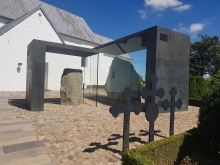
In the Viking age (800 - mid 1100 AD), the Scandinavian people lived in small Germanic kingdoms known as petty kingdoms. These minor Scandinavian kingdoms scattered in the continents.
Swedish Viking is known as the Roden since the active raiders were from the area of Uppland called "Roslagen". It used to be the name of all coastal areas in the Baltic sea, including the eastern parts of lake Mälaren, Sweden. The last viking country that adopt the christianity was Sweden. The evidence was the "Ansgar Cross" which is the symbol of Saint Ansgar who visited the islands and attempted to convert the Norse religion to Christianity.
The Archbishop of Hamburg-Bremen who was given the mission to bring Christianity to Northern Europe, Denmark, Norway and Sweden. Later, he became the "Apostle of the North" . One of Ansgar churches is built in Flensburg - the North boarder of Germany:
He was buried in Bremen in 865. A Celtic cross in the cemetery of Soro Abbey, Denmark looks very similar to Ansgar cross:
A Christian cross with a nimbus that has a ring shape like a halo. The Ansgar cross in Sweden is located in Björkö - the oldest ancient remains on the island or Birka settlement, originated around 800 AD. Most runestones were found in Sweden. These memorial stones were written in Runic alphabets. Runic script is an old Germanic language before the adoption of Latin alphabets that came with Christianity around 700-1100 AD. In Denmark, the serpent is told to be from the garden of Eden (Article: Viking Runestones):
Nowadays, the usage of runic alphabets are for decorative purpose in some rural area of Sweden. Lindworm is a popular motif on runestones in the 11th century. It looks like a snake, serpent or a small dragon. The white lindworm is a sign of good luck. the Legend of Lindworm's twin is in the scandinavian folktales, shown on U871 runestone:
In Norse mythology, it could be Dragon or serpent - Níðhöggr eating the roots of the world tree - Yggdrasil. The twisting snakes and dragons represent the end of the world according to the Norse legend of Ragnarök (The End of the World). Since the inscription is in the lindworm bodies, sometime it is designed to be read with other runestones:
U 72 was found in 1896. It is originally in Hägerstalund farm in the Hansta district of Stockholm. There were two runestones and this one was removed to Skansen. The inscription describes that sons of Ingas (mother), Ernmund and Ingemund inherited the farm from his father. They traveled to Greece and died there. When the mother died, her brother Gärdar and Jorund took over the farm. The stones show that these runestones were made at the end of Viking age (mid 1000.AD). As you can see there was no cross in the ancient ruinstones(the symbol of christianity). This came later because so far the Norsemen believed in Norse mythology or better say Multi-Gods.
Another version of serpent in Asian countries, there is a folktale about white snake called The Legend of the White Snake (Article: The Immortality Pill) As serpents are similar to the Dragon, many legends are told in many cultures all over the world, especially the dragon slayers. Serpents are not always evil afterall. Let's slaughter the dragon or serpent begins (only in the game)!






